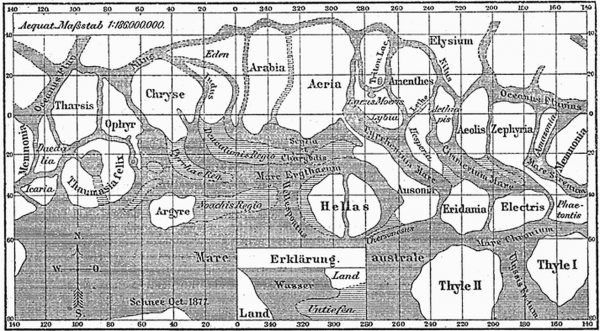
Giovanni Virginio Schiaparelli (1835-1910) was an Italian astronomer who inadvertently set off speculation that there was civilised life on Mars. Observing Mars in 1877, Schiaparelli saw linear features which he called (in Italian) canali. The word means “channels” but was mistranslated into English at “canals”. This was taken as evidence of a civilisation on Mars, and ever more fanciful conjectures about the Martian civilisation followed (Freedman & Kaufmann, 2008). Although later observations showed that the canals did not in fact exist, speculation about life on the red planet continues to this day.

What are we looking for? All living things need nutrients and a source of energy. Most particularly, all life as we know it needs a liquid solvent to support cellular processes. Accordingly, the search for life has become a search for the signatures of life, and particularly a search for water (Farmer, 2005) (Dominik & Zarnecki, 2010). Note that a liquid solvent is required – we need to find liquid water, not ice or water vapour. Life (as we know it) is made up of carbon-based molecules – organics. The presence of organics is a prerequisite for carbon-based life, but organics are widespread through space and are not proof of the presence of life.
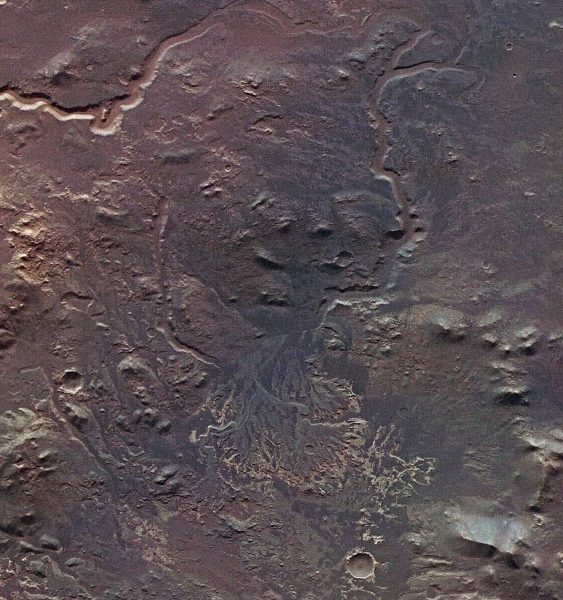
The search for life on Mars has included experiments looking for organic compounds, but most particularly the searchers have “followed the water” – identifying features consistent with the presence of liquid water now or in the past. Current Martian environment The grainy black & white images returned by Mariner 4 in 1965 showed Mars to be a desolate, cratered place with no obvious signs of life (NASA, 2005). Apart from some indeterminate results from the Viking missions of the 1970s, we have since failed to find any definitive sign of life on Mars. Physical characteristics Mars is about half the diameter of Earth but with one-tenth the mass. It orbits some 50% further from the Sun but has a 24 hour day, like Earth.
Atmosphere
The surface gravity and escape velocity being so low, Mars has lost most of its atmosphere to space. The Martian atmosphere is about 6/1000s of Earth’s. The atmosphere is 95% carbon dioxide with only 0.13% oxygen. Oxygen breathing organisms familiar to us on earth are unlikely to thrive in this atmosphere. However, recent discoveries of so-called extremophiles on Earth, have told us that life can flourish in the most unlikely circumstances. Mars has no ozone layer, so even though solar irradiance is much lower than on Earth, the ultraviolet radiation levels at the surface are sufficient to rapidly destroy organic molecules (NASA – CEMEX, Undated). The implication is that any remaining life forms will be found underground, not on the surface. Traces of methane exist (10 – 14ppbv). Methane has a short life of a few hundred years and must be replenished to maintain the amount detected. Court and Sephton analysed the likely sources of methane in Mars’ atmosphere and ruled out volcanism and meteorites. They concluded that the methane is replenished by endogenous biological or chemical processes (Court & Sephton, 2009).
| Parameter | Mars | Earth | Ratio (Mar/Earth) |
|---|---|---|---|
| Mass 1024 kg | 0.64171 | 5.9724 | 0.107 |
| Equatorial radius (km) | 3396.2 | 6378.1 | 0.532 |
| Mean density (kg/m3) | 3933 | 5514 | 0.713 |
| Escape velocity (km/s) | 5.03 | 11.19 | 0.450 |
| Solar irradiance (W/m2) | 586.2 | 1361.0 | 0.431 |
| Parameter | Mars | Earth | Ratio (Mar/Earth) |
|---|---|---|---|
| Semimajor axis (106 km) | 227.923 | 149.596 | 1.524 |
| Sidereal orbit period (days) | 686.980 | 365.256 | 1.881 |
| Length of day (hrs) | 24.6597 | 24.0000 | 1.027 |
| Obliquity to orbit (deg) | 25.19 | 23.44 | 1.075 |
| Surface pressure | 6.36 mb at mean radius (variable from 4.0 to 8.7 mb depending on season) [6.9 mb to 9 mb (Viking 1 Lander site)] |
|---|---|
| Surface density | ~0.020 kg/m3 |
| Average temperature | ~210 K (-63 C) |
| Diurnal temperature range | 184 K to 242 K (-89 to -31 C) (Viking 1 Lander site) |
| Atmospheric composition (by volume) | |
| Major | Carbon Dioxide (CO2) – 95.1% ; Nitrogen (N2) – 2.59% Argon (Ar) – 1.94%; Oxygen (O2) – 0.16%; Carbon Monoxide (CO) – 0.06% |
| Minor (ppm) | Water (H2O) – 210; Nitrogen Oxide (NO) – 100; Neon (Ne) – 2.5; Hydrogen-Deuterium-Oxygen (HDO) – 0.85; Krypton (Kr) – 0.3; Xenon (Xe) – 0.08 |
Temperature
The average temperature is a chilly 210K (-63C), with a diurnal range of 184 K to 242 K (-89 to -31 C) measured at the Viking 1 Lander site.
Water
The presence of liquid water is one of the fundamental requirements for life as we know it. “Mars today is too cold, with an atmosphere that is too thin, to support liquid water on its surface” (NASA, Undated). An alternative view is that tiny “microdomains” of liquid water could exist and be sufficient to support microorganisms (Miller, Case, Straat, & Levin, 2010). Moreover, brine solutions can exist at a much lower temperature than pure water, leading some researchers to assert that liquid brine may be common (Renno, et al., 2008) There is no doubt that frozen water ice exists in abundance in the polar caps and elsewhere. The south polar cap is up to 3.7km deep and contains enough water to cover the planet to a depth of 11m (NASA, 2007). Results from the Mars Reconnaissance Orbiter and the Mars Express orbiter have been used to infer large areas of water ice at shallow depths (<1m) at latitudes as low as 25°S (Vincendon, et al., 2011).
Soil
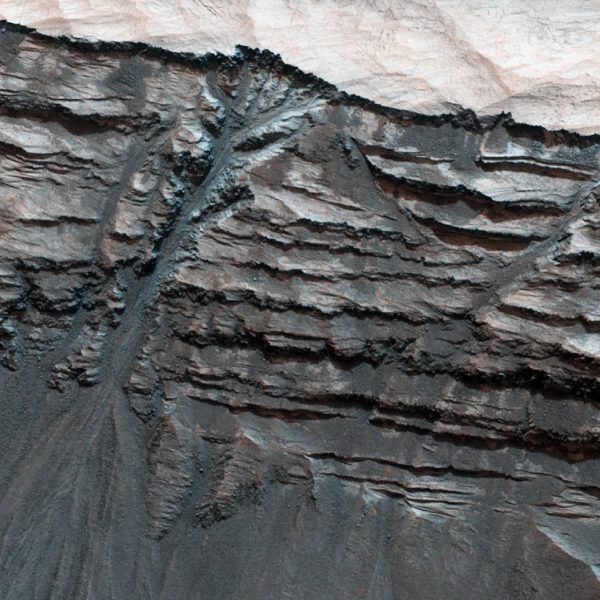
The 1976 Viking landers failed to find organics, but both sites showed perchlorates (ClO4). Analysis of the perchlorate indicated that there was contamination by chemicals used to clean the spacecraft before launch. It was concluded that there was no organic material. The Phoenix polar lander has provided a wealth of information about the soil characteristics of the north polar region. Sulphur is widespread, existing in compounds such as MgSO4 and CaSO4. If the soil had been wet in the past, epsomite and gypsum would have been formed from evaporation. Past water activity would have been above the threshold for habitability (Kounaves S. P., et al., 2010), (Kounaves S. P., et al., 2010). The Phoenix experiments also detected large quantities of perchlorate, reopening the controversy about the Viking results. Perchlorate, an ion of chlorine and oxygen, becomes a strong oxidant when heated. “It could sit there in the Martian soil with organics around it for billions of years and not break them down, but when you heat the soil to check for organics, the perchlorate destroys them rapidly”. (McKay, 2011) Haematite is an iron oxide (Fe2O3) typically deposited in an aqueous solution on Earth. The Mars Global Surveyor and Mars Odyssey spacecraft both detected the spectral signature of haematite on Mars and the rovers Spirit and Opportunity have examined small spherical haematite concretions called “blueberries”. The same objects occur on Earth and were precipitated from iron-rich groundwater. The concretions form much more quickly if particular bacteria are present (Arizona State University) (Park & Chan, 2006).
Past Martian environment
There is evidence that Mars was once a wet planet with oceans, lakes and rivers. The geomorphology, geology and soil chemistry all point to a previous time when liquid water was common on the red planet and when enormous volcanoes erupted.
Geomorphology
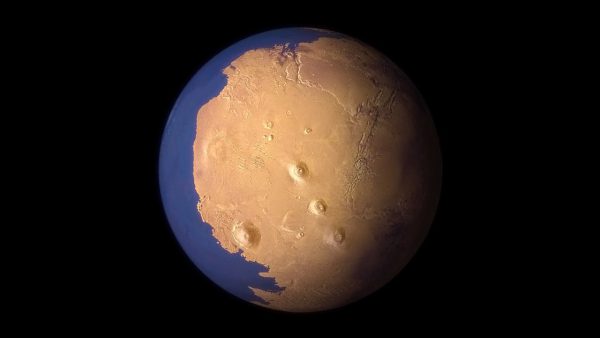
Landforms shaped by water have been revealed by high-resolution cameras in orbiters such as the Mars Reconnaissance Orbiter (MRO) and the Mars Express. Examples include the lake delta in Eberswalde Crater (Figure 3), Mars may have been a cold, wet planet in the past. Credit: UniverseToday/Taylor Perron/UC Berkeley numerous erosion channels which look remarkably like earth creek systems, and large valleys. There are a number of extinct volcanoes, most notably Olympus Mons – the largest volcano known anywhere in the solar system.
Geology
The key geological signature of a watery environment is the presence of sedimentary rocks. These have been photographed by the orbiters (Figure 6) and also by the surface rovers (Figure 7). Sedimentary rocks are widespread on Mars, indicating extensive areas of oceans or lakes. The widespread presence of haematite also points to the presence of liquid water (and possibly bacterial life forms). Fairen et al have used the distribution of phyllosilicates to suggest that any ancient oceans on Mars would have been limited to higher latitudes, and would have been near-freezing temperatures. Mars was not (under this scenario) a lush tropical world in the past. (Fair-n, et al., 2011) The Opportunity rover has been directed to search for phyllosilicates in the Endeavour Crater region, which would help confirm this scenario. (Kremer, 2011)
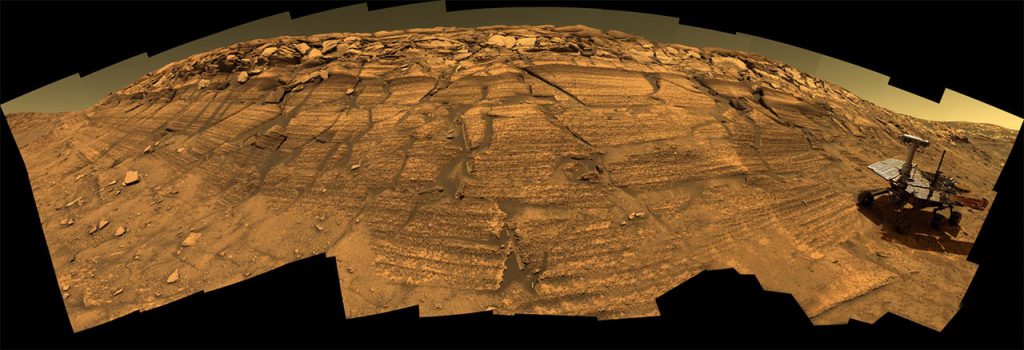
Future science
Describe science objectives for future martian spacecraft that would be needed to increase our knowledge of Mar’s past.
Future scientific investigations of Mars may develop along three lines: a) a continuing search for existing lifeforms, b) investigations of the past environment of the planet, and c) investigations to facilitate future missions to Mars.
Search for life
Continuing searches will be undertaken for the signatures of life. This includes liquid water, organic molecules and the products of life, such as methane and its degradation products. The ESA Trace Gas Orbiter will specifically search for methane and other biomarkers (ESA, 2011). The finding of perchlorates in large quantities by the Phoenix mission has reopened the controversy surrounding the Viking mission findings. Future missions will no doubt revisit the question of organic molecules and biomarkers. A range of potential target molecules has been suggested by (Parnell, et al., 2007).
Past environment
Further work must be done on the extent and nature of oceans and lakes, and former temperature environments. This may be influenced to a great extent by the past orbit of Mars, which may have been perturbed by the giant planets. In addition, the magnitude of changes in the obliquity should be examined in relation to its effect on planetary climate (Touma & Wisdom, 1993) (Nakamara & Tajika, 2003).
Future missions
The ExoMars Entry, Descent and Landing Demonstrator Module, to be launched in 2016, will test new systems for a soft landing, including thermal protection, parachutes, touch-down thrusters and a radar altimeter (ESA, 2011).
If we found life on Mars…
An unambiguous discovery of life (or past life) on Mars would be a momentous occasion for mankind. However, the discovery would open a fundamental question – did life evolve separately on Earth and Mars, or was there a common origin? It is known that meteors can travel between the planets. For example, the Allan Hills 84001 meteorite discovered in Antarctica in 1984 is thought to come from Mars and contains structures that were thought to be microbial fossils (Clinton, 1996). So it is possible that life evolved on either Earth or Mars, and was carried to the other planet. Alternatively, both planets may have been seeded with life from an external source. If life on Mars was demonstrated to exist and to have evolved separately from life on Earth, then we will know that life could evolve anywhere. It is not a once-off, and we are not alone in the universe.
For Paul’s reference list and link to more of his essay’s click here





